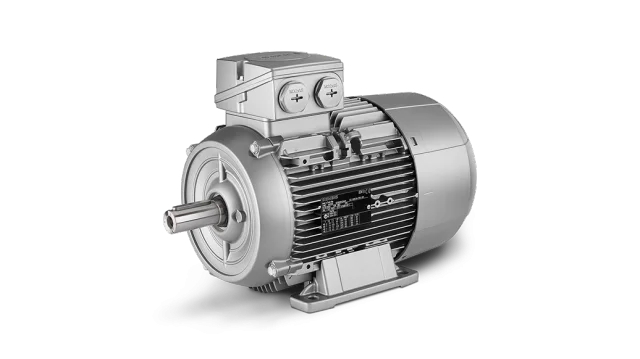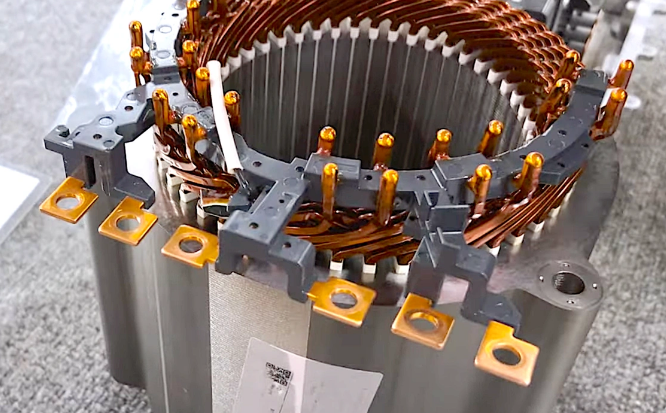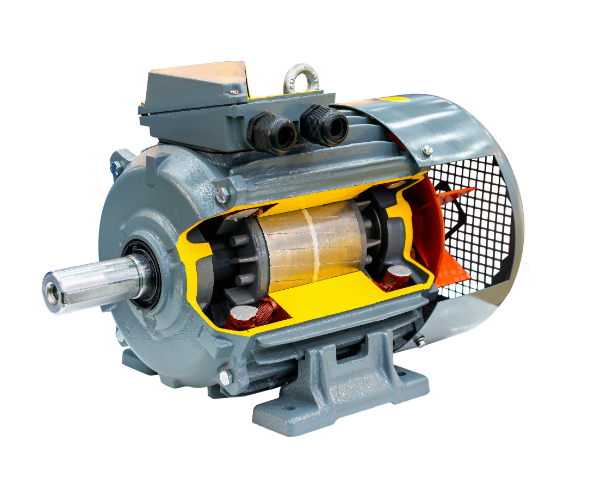Operation of a three-phase motor on single-phase power supply results in non-balanced current distribution inside the motor. A motor is under an unbalanced load condition, whereas two windings would carry excessive current and may cause overheating, damage to windings, and/or accelerated aging of insulation. The output of the motor will drastically reduce; it has poor starting properties, low efficiency, and increased vibration. It can be operated with a three-phase source without one of the phases by using a phase converter or special motor starter equipment, but this is far from ideal and not recommended for a continuing operation.
Motor Damage
A three-phase motor was designed to be driven on three-phase alternating current. This three-phase provides a rotating magnetic field within the motor. This is normally distributed evenly across the three windings in a way that each winding bears an equal load. However, in a single-phase power supply, this current can pass only one way, and thus two windings bear most of the load while the third winding either does not work or works very poorly. This immensely different situation of current passage creates a great difference in the working of the motor and brings about a number of problems, most prominently motor damage.
This also creates an excessive current in two active windings due to the uneven distribution of the current, hence overheating. An increased internal temperature speeds up the aging of insulation materials that might cause damage in the insulation layer of the winding. In motor design, the insulation material is very critical, and its failure can result in either a short circuit or an open circuit. Overheating resulting from continued running under such conditions may culminate in complete insulation breakdown and even fire hazards. Single-phase operation normally reduces the life of insulation by more than 50% and sometimes even worse.
Overheating also influences the mechanical parts of a motor, such as bearings, rotor, and stator. The rise in temperature causes expansion in those components, yielding deformation or damage. The bearings working under high temperatures produce deterioration of the lubricant in them, increasing friction and wear. In severe cases, it can seize or burn out. Overheating can thus physically distort the rotor and stator, or degrade the material of them both, leading to problems in the normal operation of the motor and also to possible failure of the motor.
Reduced Power
The main aim while designing a three-phase motor is for higher power efficient delivery. Since the three-phase power provides three simultaneous current paths, the motor can output more power with lower voltage and current. Three-phase motors can, therefore, be used broadly in industrial and commercial uses, particularly in much power requiring equipment for satisfactory efficiency.
Single-phase power is distinguished by the fact that it provides only one path for current. This means a motor cannot develop normal output power. When a three-phase motor is operated on single-phase power, its rated power drops very significantly. The power rating of a motor operating on single-phase power may be reduced to 50% to 60% of the nameplate rating. For example, a 7.5 kW-rated motor will deliver only 3.75 kW or less when connected to a single-phase power supply.
This theoretical power reduction further reaches to the motor driving the load: under heavy loads, the motor does not provide the required power in full, and malfunctioning or failure to start the load by the equipment occurs. In addition, where equipment has to operate continuously and steadily in production, this further reduces power and directly influences production efficiency, with the worst case of stopping production.

Overheating Risk
Among the most frequent and serious problems encountered in operating a three-phase motor from single-phase power is overheating. Ordinarily, the windings of a three-phase motor are uniformly loaded under normal conditions, with relatively low temperature rise. The balanced current drawn from the three-phase supply provides for stable temperature operation of the motor. But when the motor is put on single-phase supply, the distribution of current is not proper; two windings contain excessive current resulting in high temperature in the windings.
Under single-phase power, the increased temperature would affect not only the acceleration in aging of the insulation of the winding but also the mechanical parts of the motor. A very straightforward result of this temperature rise is its direct consequence on the efficiency of the motor. While the temperature increases, internal losses such as copper losses and electromagnetic losses also tend to increase, resulting in more electrical energy being converted to heat.
The temperature rise in a three-phase motor increases with the load applied; under normal three-phase power, though, this increase evens out and has little impact on the motor’s lifetime. Under single-phase power conditions, this imbalance can quickly result in overheating, even in a matter of minutes, which usually leads to irreparable damage. The temperature of the motor can be higher by 10 to 30°C in contrast to normal operating conditions, while its long running under these conditions will accelerate the aging of insulation until it results in the failure of the motor.
Yet at the same time, severe overheating badly influences the motor performance of a start and stability. High temperatures reduce starting torque that is able to make it problematic for the motor to start. Besides, during starting, the motor may suffer from over-increased current leading to overload protection, and even failure of start. Overheating is also possible to accelerate the wear and tear of various motor parts that decreases the overall efficiency.
Increased Vibration
A three-phase motor operates in a very low vibration mode, especially when the motor operates within a specific-favorable operating region where current distribution is uniform and torque and speed remain constant. In such a case, the mechanical vibration is minimal. However, when the three-phase motor is operated with single-phase input, the above-mentioned unbalanced distribution of current causes fluctuation in the motor’s torque and speed, thus creating increased vibration.
Operating conditions for the motor under single-phase power are much worse as compared to the three-phase power supply. Due to the non-uniform current distribution, the speed of the rotor fluctuates to increase its vibration. It had been determined from several studies that the amplitude of the vibration for a three-phase motor increases by as much as 1.5 to 2 times under single-phase powering. The problem is that this excessive vibration not only adversely affects the motor itself but can even do damage to surrounding equipment and even to the structures that the motor operates within.
Prolonged periods of excessive vibration may result in quick wearing of the bearings, stators, rotors, and other parts of the motor. Extra overloaded vibration may also lead to earlier failure of the bearings that, in turn, change the air gap between the rotor and the stator, thus affecting the normal functioning of the motor. Besides, excessive vibration will result in loosening of all mounting brackets and other parts that may increase the chances of failure.
This could even set off a chain reaction that ripples throughout the other equipment and systems nearby. Undue vibration can destroy pipes, conveyors, and connectors in the equipment, thus upsetting the stability of the whole production line.
Efficiency Loss
A three-phase motor is much more efficient because current balance is able to minimize electromagnetic and copper losses, so most of the electrical energy is thereby converted into useful mechanical energy. Such is because one-phase power supply results in uneven distribution of current, increasing the internal loss to give reduced overall efficiency of the motor.
Due to this unbalancing, a heavy rise takes place in both electromagnetic losses and copper losses within the motor. In normal conditions, three-phase current is distributed uniformly among three windings, reducing effectively the losses in current. In single-phase power, the concentrated current causes both increased electromagnetic losses and copper losses, which requires the motor to take in more electrical energy in order for it to continue with its operation normally, thereby reducing efficiency.
Single-phase power reduces the efficiency of a three-phase motor by 10% to 30%. The loss in efficiency increases energy consumption for the same load and also increases the running cost, especially in the long-duration high-load applications of the motor.
Its decreased efficiency further reduces the operational stability of the motor. Operating under a lowered efficiency, the motor may not deliver enough power to sustain the load, which then causes unstable operation. In such a case, if the load fluctuates much, this kind of issue may frequently lead the motor into downtime, overload protection, and so on, which disrupts production continuity and stability.

Startup Issues
The startup process of a three-phase motor relies on the balanced currents provided by a three-phase power supply; this provides a rotating magnetic field that offers ample starting torque. On single-phase power, however, the current imbalance would not be able to afford the motor the required amount of torque for starting.
The rated current supplied by a single-phase power cannot give a balanced effect with three-phase current; the latter is not able to generate a stable rotating magnetic field, which is why it cannot supply enough starting torque. Normally, a motor’s starting torque should be 2-3 times its full-load torque; however, a motor powered by single-phase power might have a severe shortage of it and hence can hardly permit the motor to start or even sometimes not allow the motor to start.
Large current fluctuation during startup may also sag the voltage in the power grid and affect the normal use of other equipment. The fluctuations also put additional mechanical stress on the motor, creating overload conditions at startup. In order to prevent this, the motor may trigger overload protection and stop, disrupting normal production.
At startup, the current of the motor can be five times its rated current or more. This puts an extra strain on the power grid. If the motor takes more time at this kind of start, it may affect the power grid’s stability and may even trigger overload protection on either the motor or the grid.
Shortened Lifespan
The life of a three-phase motor will relate to the type of load it sees, the environment of operation, and maintenance. Operating a three-phase motor on single-phase power, however, will definitely drive the motor into an unstable operating condition that can shorten the life of the motor considerably.
Insulation of the motor is one of the most important factors that determine the life span. Under single-phase power, due to unequal currents and high temperatures, their deterioration in winding’s insulation materials is much faster. A three-phase motor on a single-phase power supply usually suffers a reduction in its lifespan by 20%-50%. This normally happens when the operation under heavy-load conditions takes longer, with an even more significant reduction in its lifetime.
The unbalanced driving of current also accelerates the wear of the mechanical parts of the motor. Due to high vibration and heating, bearings, rotors, and stators are more likely to fail; thus, making mechanical components of the motor shorter in life.







